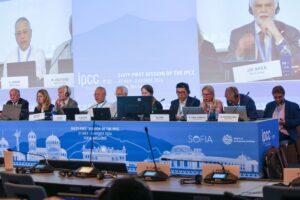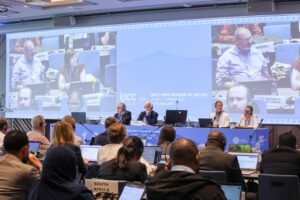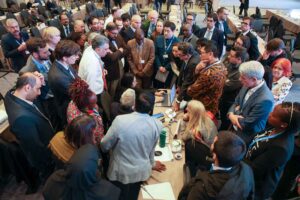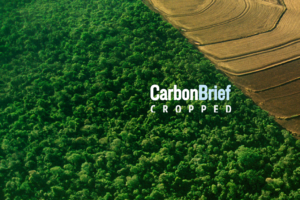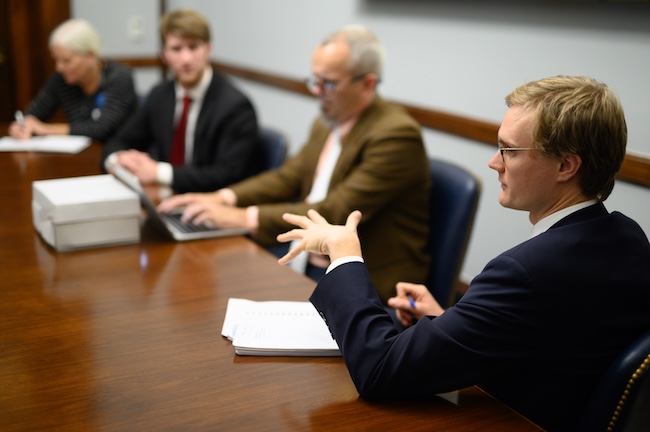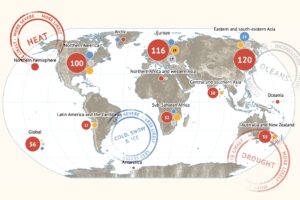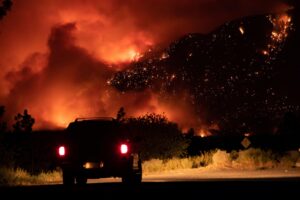Last week’s Intergovernmental Panel on Climate Change (IPCC) meeting in Hangzhou, China, marked the third time that governments have failed to agree on a timeline for the organisation’s seventh assessment cycle (AR7).
A large group of countries pushed for the reports to be published by the end of 2028, to allow them to feed into the UN’s second global stocktake – a mechanism that will gauge progress towards the Paris Agreement goals.
However, others – including the Chinese hosts – pushed for a longer deadline, warning of “compression in the timeline” that could affect participation, particularly from developing countries.
The meeting ran over by more than 30 hours, meaning that many small delegations – especially small-island developing states and least-developed countries – were unable to stay to the end.
As a result, the final decisions were made without their participation.
According to the Earth Negotiations Bulletin (ENB), reporting from inside the meeting, timeline discussions will be taken up again in the next IPCC meeting in late 2025, “with hope that the panel can finally break its deadlock”.
“The absence of a timeline puts potential contributing scientists in a difficult position,” one IPCC scientist tells Carbon Brief.
He notes that the “call for authors” will open soon, but warns how challenging it will be to accept a nomination “if there is no clarity on when a massive time commitment for the IPCC is expected”.
The meeting also saw outlines agreed for AR7’s three main reports – despite the “entrenched positions” of some delegations “complicating efforts to find consensus”, the ENB reports.
Speaking to Carbon Brief, IPCC chair Prof Jim Skea says the process was “probably the most difficult session I can recall”.
In a further complication, reports emerged ahead of the meeting that US officials had been denied permission to attend and a contract for the technical support unit of one of the working groups had been terminated.
It was the first US absence in IPCC history.
Skea says that the IPCC will “have to start thinking more seriously” about how to manage a potential US withdrawal, but the priority last week had been to “get through” the meeting and its lengthy agenda.
He adds that the IPCC has still “had no formal communication from the US at all”.
Below, Carbon Brief unpacks the deliberations at the meeting and the decisions that were made.
- Splits in Sofia
- US no-show
- AR7 schedule
- Assessment report outlines
- CDR report
- Expert meetings
- China host
Splits in Sofia
IPCC “sessions” are meetings that bring together officials and experts from member countries and observer organisations.
Collectively, they decide on the work of the IPCC, including the scope, outline and timeline for reports – all overseen by the IPCC’s “bureau” of elected scientists.
With its sixth assessment report (AR6) completed in 2023, the focus of the IPCC has turned to the seventh assessment (AR7) and the reports it will deliver over the next five years.
At its meetings in Istanbul and Sofia in 2024, the IPCC agreed that AR7 should include – among other outputs – the traditional set of three “working group” reports, one “special” report on cities and two “methodology” reports on “short-lived climate forcers” and “carbon dioxide removal technologies, carbon capture utilisation and storage”.
The three working group reports – each typically running to thousands of pages – focus on climate science (WG1), impacts and adaptation (WG2) and mitigation (WG3).
However, the timeline for these reports was not agreed at either meeting. Countries were split on whether the working group reports should be published in time to inform the UN’s second global stocktake, which will be completed in 2028. The stocktake will gauge international progress towards the Paris Agreement goals. (See: AR7 schedule)
The final decision on the AR7 timeline was, thus, postponed to 2025. As a result, the Hangzhou meeting would need to revisit the timeline – as well as approve the scope and outline of the working group reports themselves.
The Hangzhou meeting, originally slated for five days over 24-28 February, brought together almost 450 participants from governments, international organisations and civil society – including 300 delegates from 124 member countries and 48 observer organisations.
IPCC chair Prof Jim Skea tells Carbon Brief that the agenda contained “six days’ worth [of items] rather than five” and they “started with three sessions a day right from the beginning to try and get ahead”.
US no-show
Just a few days before the meeting opened, Axios reported that government officials from the US had been “denied” permission to attend. Furthermore, it said, the contract for the technical support unit for WG3 had been “terminated” by its provider NASA, meaning its staff “will also not be traveling to China or supporting the IPCC process moving forward”.
(Each working group has a technical support unit, or TSU, which provides scientific and operational support for report authors and the group’s leadership.)
In further reporting, Nature quoted a NASA spokesperson, who said that the move was prompted by guidance “to eliminate non-essential consulting contracts”. The Washington Post reported that the group of 10 TSU staff “still have their jobs…but have been blocked from doing any IPCC-related work since 14 February”. Bloomberg added that WG3 co-chair and NASA chief scientist Dr Kate Cavlin would also not attend the meeting.
Axios speculated that the move “could be the beginning of a bigger withdrawal from US involvement in international climate science work”.
Carbon Brief analysis suggests that the US has provided around 30% of the voluntary contributions to IPCC budgets since it was established in 1988. Totalling more than 53m Swiss francs (£46m), this is more than four times that of the next-largest direct contributor, the European Union.
The first Trump administration cut its contributions to the IPCC in 2017, with other countries stepping up their funding in response. The US subsequently resumed its contributions.


Chart showing the 10 largest direct contributors to the IPCC since its inception in 1988, with the US (red bars), European Union (dark blue) and UNFCCC (mid blue) highlighted. Grey bars show all other contributors combined. Source: IPCC (2025) and (2010). Contributions have been adjusted, as per IPCC footnotes, so they appear in the year they are received, rather than pledged.
Speaking to Carbon Brief, Skea says the absence of the US at the meeting itself “didn’t disturb the basic way that the meeting operated”. He adds:
“Every meeting we have 60 countries that don’t turn up out of our membership – the US was now one of that group. I mean, frankly, nobody within the meeting mentioned the US absence. We just got on and did it.”
On the longer-term implications, Skea says that “we didn’t spare an awful lot of time for thinking about”. However, the IPCC will “have to start thinking more seriously” once they have more information, he says, noting that “we have had no formal communication from the US at all”.
Regarding the WG3 TSU, there is no “comparable circumstance” in the IPCC’s history, Skea says. Typically, the co-chair from a developed country is “supposed to bring support for a TSU with them”, he says. (Each working group has two co-chairs – one from a developed country and one from a developing country.) However, the WG3 TSU is already partly supported in Malaysia, where co-chair Prof Joy Jacqueline Pereira is based.
(As an IPCC progress report for the Hangzhou meeting points out, the WG3 TSU has already “taken shape”, although it is not yet fully staffed. The “node” in Malaysia was established with the donor support of the US, Norway and New Zealand. There is also a job advert for a “senior science officer” in the WG3 TSU currently on the IPCC’s website.)
Skea suggests that the situation can be resolved with “creative solutions”, adding that the IPCC “can take any decision, regardless of past principles or past decisions. So I think, with ingenuity, there will be ways around it.”
Prof Frank Jotzo, a professor of environmental economics at the Australian National University’s Crawford School of Public Policy and WG3 lead author on AR5 and AR6, describes the situation as “highly unusual”. He tells Carbon Brief:
“I would expect that other developed countries will come to the rescue to fund the WG3 TSU, to rescue the process and to demonstrate that Trump will not upend this multilateral process. Staff positions could then presumably be either in those countries or in Malaysia, home of the other WG3 co-chair.”
On the US involvement in the IPCC more broadly, CNN reported the comments of a “scientist involved in the report”, who said they were “not sure” what the block on US officials will mean for the planned work going forward, or “if US scientists will participate in the writing of the IPCC reports”.
Science reported that, although US contributions to the IPCC are “typically run out of the White House by the Global Change Research Programme, NASA is the lead on managing GCRP’s contracts”. It added that “NASA leadership, not GCRP, decided to end the TSU contract”.
Following the China meeting, member states are set to solicit nominations of scientists to author the working group reports in AR7, Science explained:
“GCRP usually runs the process [for the US], but the administration’s moves have some wondering whether it will proceed as normal. If not, IPCC does allow scientists to self-nominate without their country’s involvement. But US authors might be shut out anyway if travel funding ends.”
For example, the US nominated 250 scientists to be authors on the special report on cities, which will be part of the AR7 cycle. (Authors can also be nominated by other countries, observer organisations and the IPCC bureau.)
Dr Gavin Schmidt, director of the NASA Goddard Institute for Space Studies, posted on social media last week that, “despite some reports, there is no blanket prohibition on US scientists interacting with or serving with the IPCC”.
AR7 schedule
A key agenda item for the Hangzhou meeting was to finalise the timeline for publishing AR7 reports. This is a contentious point on which delegates were unable to reach an agreement at either the Istanbul or Sofia meetings.
Heading into the meeting, countries were split on whether the working group reports should be published in time to inform the UN’s second global stocktake, which will be completed in 2028.
In the IPCC plenary on Saturday afternoon, Skea emphasised the “enormous effort and time” taken over this decision – including during the scoping meeting at Kuala Lumpur – and stressed the importance of an integrated approach to planning across the three working groups.
The working head of the WG2 TSU put forward the proposed schedule for AR7 cycle, which would see all working group reports published in time to feed into the second global stocktake in 2028.
A long list of countries underscored the importance of a “timely, policy-relevant” AR7 cycle, urging the adoption of the schedule put forward by the IPCC bureau in order to avoid failing to reach an agreement, according to the ENB. These included the UK, EU, Australia, Japan, Luxembourg, Turkey and Jamaica. (Jamaica was speaking on behalf of the other small island developing states who were unable to stay past the scheduled close of the plenary session.)
However, India, Saudi Arabia, Algeria and South Africa called for the schedule to be revised, citing “time compression in the timeline and challenges for scientists from developing countries to produce literature”, the ENB reports. And Kenya “expressed concern about inclusivity and called for more flexibility on timing”.
At this point, many countries raised concern about the number of countries who had already left the session, with Australia noting that “many of them are precisely those who lack capacity and depend on IPCC’s assessments”.
Skea stressed the need to agree a timeline in this meeting so that work on the main reports – including author selection – could progress. Discussions continued in a huddle throughout Saturday afternoon and into the evening.

Late on Saturday evening, Italy and Ireland, supported by a handful of other countries, suggested an additional option to stretch the timeline to allow an extra month of “wiggle room”.
However, India and South Africa “said the addition of one or two months did not make it a viable counter-suggestion”, according to the ENB. The three countries instead suggested completing the WG1 report by July 2028, WG2 in December 2028, WG3 in April 2029 and the synthesis report in the second half of 2029.
To move forward, Skea proposed agreeing on the outlines of the working groups and inviting experts to start their work, including putting out the call for author nominations and convening the first lead authors meeting in 2025. However, he said that the timeline decision would be deferred until the next IPCC meeting in late 2025.
Skea tells Carbon Brief that the meeting was helpful for “clarifying where different groups of countries were coming from”. He says that the opposition to a stocktake-aligned timeline was “not about the outcome and the synchronisation with the political process”, but, rather, “the needs of countries for doing their reviews of the [report] drafts – how frequently, how rapidly, they were coming”.
Even with the two options – a proposed timeline and a counter suggestion – resolving remaining differences won’t be “easy”, Skea says, adding that “I think we will be off to do a little bit of consultation offline before we get to IPCC-63 to see how we resolve it”.
“The absence of a timeline puts potential contributing scientists in a difficult position,” Rogelj tells Carbon Brief. He adds:
“My understanding is that a call for authors will be launched soon. However, how can one accept a nomination or subsequent selection if there is no clarity on when a massive time commitment for the IPCC is expected. It shows how political games regarding the timing of scientific evidence for the negotiations dominate considerations for authors and considerations of delivering the best possible report.”
WG2 co-chair Prof Bart van den Hurk tells Carbon Brief that the failure to agree on a timeline means that experts invited to take part in reports “will not receive a schedule for all the meetings they’re supposed to attend”, leading to possible agenda clashes later.
It also means that they “don’t know for how long they’re signed up for this time-intensive yet voluntary role, which is a big ask”, he adds.
Prof Lisa Schipper, a professor of development geography at the University of Bonn and IPCC AR6 author, warns that the delay in agreeing the AR7 timetable reflects a shift in geopolitics. She tells Carbon Brief:
“Given how climate change is getting sidelined by security and other issues, it will not surprise me if the delay of the AR7 schedule will pass largely unnoticed or seem like just a detail to most. But there is greater reason to be concerned.”
Dr Céline Guivarch, a professor at Ecole des Ponts ParisTech and IPCC AR6 lead author, adds that “it’s just another symptom of how tense the international situation is and how difficult multilateralism is”.
Assessment report outlines
Heading into the Hangzhou meeting, countries had agreed to produce a full set of assessment reports with a synthesis report, along with a special report on climate change and cities and two methodology reports.
The scope, outlines and titles for WG1, WG2 and WG3 reports were prepared at a meeting in Kuala Lumpur in December 2024, to be reviewed and approved in Hangzhou.
At the scoping meeting, some experts suggested that reports should include “plain-language summaries”, because local authorities, companies and the general public often do not know the “jargon”, the ENB reports.
When brought to the Hangzhou meeting, countries including Australia, France and Vanuatu supported this suggestion, stressing the importance of accessibility. Some countries also called for shorter reports focused on new science.
However, the Russian Federation, India and Saudi Arabia were opposed, the ENB says. The Russian Federation argued that the report is intended for an expert audience and India said that these summaries “would compete with the [summary for policymakers] and IPCC outreach mechanisms”, adding that any plain-language summaries would need to be approved line-by-line.
Later, the WG1 co-chairs suggested changing “plain-language summaries” to “plain-language overviews,” in which authors provide a chapter overview, including graphics, in a similar manner to the FAQs sections.
About 20 countries, including the UK, Canada, Ukraine, Chile, China and Libya, supported the suggestion. However, Algeria, Russian Federation, India and Saudi Arabia continued to oppose it, the ENB says.
A “huddle” was convened to find consensus, which, ultimately, agreed to delete any reference to “plain language overviews” and instead encouraged authors to ensure that the executive summary of each report is clear.
The countries then discussed the proposed outline for each working group report in turn. Skea tells Carbon Brief that this process “had some of the quality of an approval session” for a finished report, adding:
“But people did compromise in the end and we did get the outlines of the reports agreed, which, for me, was the real objective of the meeting.”
For WG1, many countries welcomed the proposed outline and some suggested changes. For example, Switzerland called for addressing the unique challenges faced by high altitude and latitude environments. And India asked for the inclusion of a chapter on monsoons and deletion of a chapter on climate information and services, the ENB says.
When discussing the chapter on abrupt changes, tipping points and high-impact events in the Earth system, Saudi Arabia and India objected to singling out “tipping points” in the title and suggested deleting them, the ENB says. However, Switzerland, supported by a handful of other countries, highlighted their relevance for policy and science and called for them to be kept in.
On Friday, after a huddle, the title was changed to: “Abrupt changes, low-likelihood high-impact events and critical thresholds, including tipping points, in the Earth system.”
Delegates agreed on the following chapters for the WG1 report:
- Chapter 1: Framing, methods and knowledge sources;
- Chapter 2: Large-scale changes in the climate system and their causes;
- Chapter 3: Changes in regional climate and extremes and their causes;
- Chapter 4: Advances in process understanding of Earth system changes;
- Chapter 5: Scenarios and projected future global temperatures;
- Chapter 6: Global projections of Earth system responses across time scales;
- Chapter 7: Projections of regional climate and extremes;
- Chapter 8: Abrupt changes, low-likelihood high impact events and critical thresholds, including tipping points, in the Earth system;
- Chapter 9: Earth system responses under pathways towards temperature stabilisation, including overshoot pathways; and
- Chapter 10: Climate information and services.
On the WG2 report outline, Kenya said AR6 definition of maladaptation is “limiting” and called for the term to be redefined for the new report, the ENB says. Meanwhile, Brazil and Switzerland called for the report to assess the risks of solar radiation management, given its cross-cutting nature and potential impacts on sectors, such as agriculture.
Senegal underscored the need for a focus on losses and damages, expressing hope that this will “help showcase those in greatest need”. And Saudi Arabia called for a full assessment of the potential of carbon dioxide removal (CDR) technologies.
Delegates agreed on the following chapters for the WG2 report:
Global assessment chapters:
- Chapter 2: Vulnerabilities, impacts and risks;
- Chapter 3: Current adaptation progress, effectiveness and adequacy;
- Chapter 4: Adaptation options and conditions for accelerating action;
- Chapter 5: Responses to losses and damages; and
- Chapter 6: Finance.
- Chapters 7-13 are regional assessment chapters on Africa, Asia, Australasia, Central and South America, Europe, North America and small islands.
Thematic assessment chapters:
- Chapter 14: Terrestrial, freshwater and cryospheric biodiversity, ecosystems and their services;
- Chapter 15: Ocean, coastal, and cryospheric biodiversity, ecosystems and their services;
- Chapter 16: Water;
- Chapter 17: Agriculture, food, forestry, fibre and fisheries;
- Chapter 18: Adaptation of human settlements, infrastructure and industry systems;
- Chapter 19: Health and well-being; and
- Chapter 20: Poverty, livelihoods, mobility and fragility
Among the comments on the WG3 outline, the Russian Federation cautioned against discussing national policies – describing this as “beyond [WG3’s mandate], the ENB says. Belgium suggested including social tipping points in the report, the ENB says, while Saudi Arabia argued the IPCC reports “should be neutral with respect to policy and called for a full assessment of the potential of carbon dioxide removal (CDR) technologies”.
Delegates agreed on the following chapters for the WG3 report:
- Chapter 1: Introduction and framing;
- Chapter 2: Past and current anthropogenic emissions and their drivers;
- Chapter 3: Projected futures in the context of sustainable development and climate change;
- Chapter 4: Sustainable development and mitigation;
- Chapter 5: Enablers and barriers;
- Chapter 6: Policies and governance and international cooperation;
- Chapter 7: Finance;
- Chapter 8: Services and demand;
- Chapter 9: Energy systems;
- Chapter 10: Industry;
- Chapter 11: Transport and mobility services and systems;
- Chapter 12: Buildings and human settlements;
- Chapter 13: Agriculture, forestry and other land uses (AFOLU);
- Chapter 14: Integration and interactions across sectors and systems; and
- Chapter 15: Potentials, limits and risks of carbon dioxide removal.
CDR report
Among the other items on the Hangzhou agenda was the finalisation of the scope and outline of a methodology report on carbon dioxide removal (CDR) and carbon capture, utilisation and storage (CCUS) technologies, slated for publication in 2027.
At a scoping meeting held in Copenhagen in October, the IPCC’s task force on national greenhouse gas inventories – which is coordinating the methodology report – agreed on a title, scope and outline for the forthcoming report.
Delegates in Hangzhou failed to reach agreement on the plan for the report, after disagreements emerged around chapter seven of the proposed outline – which looks at carbon removals from oceans, lakes and rivers.
A number of delegations – including India, France, Belgium, Chile and Turkey – objected to the inclusion of a standalone chapter in the methodology report on carbon removal from waterbodies, the ENB says. The countries argued there is insufficient understanding of the environmental impacts and effectiveness of certain marine CDR technologies, including ocean alkalinity enhancement.
Saudi Arabia was among the countries that argued in favour of a chapter on carbon removal from waterbodies. The Gulf nation said that its removal would set a “worrying precedent” and be a “bad sign” for emerging technologies, according to the ENB.
With no consensus reached, delegates agreed on the title and chapters one to six of the report, but postponed further deliberations on chapter seven until the next plenary meeting.
IPCC chair Skea tells Carbon Brief that delegates “were extremely close to getting agreement” on the report, but had been hampered by a lack of “ingenuity and time”.
He adds that a solution which helped broker agreement on the outline for the special report on short-lived climate forcers at the last IPCC plenary meeting could offer a path forward for the methodology report. (After a debate arose around the inclusion of hydrogen emissions in that report, country delegations compromised on a footnote stating the matter would be addressed in a future cycle.) Skea explains:
“The [IPCC’s] task force on national greenhouse gas inventories always has this issue as to whether there’s enough scientific evidence to justify bringing a technology or a technique in. If there are doubts about the quality of the basic evidence for bringing it in, there are devices for kicking the can down the road just a little bit.”
Some insiders speculated that the standoff over the methodology report in Hangzhou could have consequences for the overall AR7 timeline. They told Carbon Brief the delay to the report’s start could result in shifted review periods and necessitate an extra approval plenary in 2028.
Expert meetings
A number of expert meetings and workshops were approved in Hangzhou.
This included two workshops designed to explore “new and extended” methods of assessment at the IPCC. One will focus on the incorporation of diverse knowledge systems, including Indigenous and local knowledge, while the other will look at the use of emerging technologies, such as artificial intelligence.
An expert meeting on methodologies, metrics and indicators for assessing climate change impacts was also approved.
Proposals to hold an expert meeting on high-impact events and Earth system tipping points, however, proved contentious and were deferred to a later session. Rifts emerged around the concept of “tipping points” and the format of the event, the ENB says.
The lengthy nature of discussions about expert meetings and workshops prompted a number of countries – and IPCC chair Skea – to articulate concerns around the general state of decision-making at the meeting, according to the ENB.
In a “progress report” session where the IPCC bureau updated members on its activities, Saudi Arabia voiced concern about briefings given by the IPCC to the International Court of Justice (ICJ), which is drawing up an advisory opinion on states’ climate-related obligations. Skea said that briefings had been limited to “purely scientific” information, the ENB says.
In a session which took place as talks overran into Saturday morning, a number of countries called for greater collaboration between the IPCC and its biodiversity-focused counterpart, the Intergovernmental Science-Policy Platform on Biodiversity and Ecosystem Services (IPBES). However, others pointed to the difference between IPBES and IPCC review processes.
China host
The Hangzhou meeting marks the first time an IPCC bureau meeting has been held in China. It is also the first major climate conference hosted by the nation since the Tianjin talks organised by the UNFCCC in 2010 after negotiations faltered at the COP15 climate summit in Copenhagen.
The 34-member IPCC bureau features one scientist from China – meteorologist Dr Zhang Xiaoye, who is co-chair of WG1.
Coverage of the meeting in national and local Chinese media focused largely on statements and comments from government officials, including national climate envoy Liu Zhenmin and spokespeople for the foreign ministry and the China Meteorological Association.
Officials stressed China’s “active” contribution to global climate action, but stopped short of characterising the nation as a climate leader.
For example, in comments captured by the Economic Observer, foreign ministry spokesperson Lin Jian characterised China as a “fellow traveller” in the “green transformation” of the global south.
China Meteorological Administration director Chen Zhenlin said the nation stood willing to “cooperate extensively with all parties to jointly respond to extreme weather and climate risk challenges” and “jointly build a community with a shared future for mankind in the field of climate change”, according to Science and Technology Daily.
A number of Chinese publications – including the Paper, Xinhua and China Daily – reported on closing comments made by IPCC chair Jim Skea, which emphasised China’s critical role in international climate governance.
Yao Zhe, policy analyst at Greenpeace East Asia, says that hosting the conference allowed China to demonstrate “its support for climate science and its genuine interest in continuing international engagement on climate”. However, she tells Carbon Brief that she saw a “gap in expectations”:
“China sees itself mainly as a hospitable host, but others at the conference expect it to help build consensus and take a more progressive stance. I think this points to an emerging question in the broader landscape: The bar for China’s climate leadership will only rise as its influence on climate policy and cleantech markets grows. But when will China be ready to meet these expectations?”
Observers told Climate Home News they had witnessed a disconnect between Chinese officials’ public statements of support for cooperation on climate change and their positions in closed-door negotiations, which included a push to keep the next round of IPCC reports out of the next global stocktake.
On the last official day of the conference, Peru announced its offer to host the next session of the IPCC in the final quarter of this year. The exact date is still to be determined as there is “still some debate about where it sits in relation to COP30 – for example, before or after”, says Skea.
The post IPCC report timeline still undecided after ‘most difficult’ meeting in China appeared first on Carbon Brief.
IPCC report timeline still undecided after ‘most difficult’ meeting in China
Greenhouse Gases
Cropped 13 August 2025: Fossil-fuelled bird decline; ‘Deadly’ wildfires; Empty nature fund
We handpick and explain the most important stories at the intersection of climate, land, food and nature over the past fortnight.
This is an online version of Carbon Brief’s fortnightly Cropped email newsletter. Subscribe for free here.
Key developments
‘Deadly’ wildfires
WINE BRAKE: France experienced its “largest wildfire in decades”, which scorched more than 16,000 hectares in the country’s southern Aude region, the Associated Press said. “Gusting winds” fanned the flames, Reuters reported, but local winemakers and mayors also “blam[ed] the loss of vineyards”, which can act as a “natural, moisture-filled brake against wildfires”, for the fire’s rapid spread. It added that thousands of hectares of vineyards were removed in Aude over the past year. Meanwhile, thousands of people were evacuated from “deadly” wildfires in Spain, the Guardian said, with blazes ongoing in other parts of Europe.
MAJOR FIRES: Canada is experiencing its second-worst wildfire season on record, CBC News reported. More than 7.3m hectares burned in 2025, “more than double the 10-year average for this time of year”, the broadcaster said. The past three fire seasons were “among the 10 worst on record”, CBC News added. Dr Mike Flannigan from Thompson Rivers University told the Guardian: “This is our new reality…The warmer it gets, the more fires we see.” Elsewhere, the UK is experiencing a record year for wildfires, with more than 40,000 hectares of land burned so far in 2025, according to Carbon Brief.
-
Sign up to Carbon Brief’s free “Cropped” email newsletter. A fortnightly digest of food, land and nature news and views. Sent to your inbox every other Wednesday.
WESTERN US: The US state of Colorado has recorded one of its largest wildfires in history in recent days, the Guardian said. The fire “charred” more than 43,300 hectares of land and led to the temporary evacuation of 179 inmates from a prison, the newspaper said. In California, a fire broke out “during a heatwave” and burned more than 2,000 hectares before it was contained, the Los Angeles Times reported. BBC News noted: “Wildfires have become more frequent in California, with experts citing climate change as a key factor. Hotter, drier conditions have made fire seasons longer and more destructive.”
FIRE FUNDING: “Worsening fires” in the Brazilian Amazon threaten new rainforest funding proposals due to be announced at the COP30 climate summit later this year, experts told Climate Home News. The new initiatives include the Tropical Forests Forever Facility, which the outlet said “aims to generate a flow of international investment to pay countries annually in proportion to their preserved tropical forests”. The outlet added: “If fires in the Amazon continue to worsen in the years to come, eligibility for funding could be jeopardised, Brazil’s environment ministry acknowledged.”
Farming impacts
OUT OF ORBIT: US president Donald Trump moved to “shut down” two space missions which monitor carbon dioxide and plant health, the Associated Press reported. Ending these NASA missions would “potentially shu[t] off an important source of data for scientists, policymakers and farmers”, the outlet said. Dr David Crisp, a retired NASA scientist, said the missions can detect the “glow” of plant growth, which the outlet noted “helps monitor drought and predict food shortages that can lead to civil unrest and famine”.
FARM EXTREMES: Elsewhere, Reuters said that some farmers are considering “abandoning” a “drought-hit” agricultural area in Hungary as “climate change cuts crop yields and reduces groundwater levels”. Scientists warned that rising temperatures and low rainfall threaten the region’s “agricultural viability”, the newswire added. Meanwhile, the Premium Times in Nigeria said that some farmers are “harvest[ing] crops prematurely” due to flooding fears. A community in the south-eastern state of Imo “has endured recurrent floods, which wash away crops and incomes alike” over the past decade, the newspaper noted.
SECURITY RISKS: Food supply chains in the UK face “escalating threats from climate impacts and the migration they are triggering”, according to a report covered by Business Green. The outlet said that £3bn worth of UK food imports originated from the 20 countries “with the highest numbers of climate-driven displacements” in 2024, based on analysis from the Energy and Climate Intelligence Unit. The analysis highlighted that “climate impacts on food imports pose a threat to UK food security”. Elsewhere, an opinion piece in Dialogue Earth explored how the “role of gender equity in food security remains critically unaddressed”.
Spotlight
Fossil-fuelled bird decline
This week, Carbon Brief covers a new study tracing the impact of fossil-fuelled climate change on tropical birds.
Over the past few years, biologists have recorded sharp declines in bird numbers across tropical rainforests – even in areas untouched by humans – with the cause remaining a mystery.
A new study published this week in Nature Ecology and Evolution could help to shed light on this alarming phenomenon.
The research combined ecological and climate attribution techniques for the first time to trace the fingerprint of fossil-fuelled climate change on declining bird populations.
It found that an increase in heat extremes driven by climate change has caused tropical bird populations to decline by 25-38% in the period 1950-2020, when compared to a world without warming.
In their paper, the authors noted that birds in the tropics could be living close to their “thermal limits”.
Study lead author Dr Maximilian Kotz, a climate scientist at the Barcelona Supercomputing Center in Spain, explained to Carbon Brief:
“High temperature extremes can induce direct mortality in bird populations due to hyperthermia and dehydration. Even when they don’t [kill birds immediately], there’s evidence that this can then affect body condition which, in turn, affects breeding behaviour and success.”
Conservation implications
The findings have “potential ramifications” for commonly proposed conservation strategies, such as increasing the amount of land in the tropics that is protected for nature, the authors said. In their paper, they continued:
“While we do not disagree that these strategies are necessary for abating tropical habitat loss…our research shows there is now an additional urgent need to investigate strategies that can allow for the persistence of tropical species that are vulnerable to heat extremes.”
In some parts of the world, scientists and conservationists are looking into how to protect wildlife from more intense and frequent climate extremes, Kotz said.
He referenced one project in Australia which is working to protect threatened wildlife following periods of extreme heat, drought and bushfires.
Prof Alex Pigot, a biodiversity scientist at University College London (UCL), who was not involved in the research, said the findings reinforced the need to systematically monitor the impact of extreme weather on wildlife. He told Carbon Brief:
“We urgently need to develop early warning systems to be able to anticipate in advance where and when extreme heatwaves and droughts are likely to impact populations – and also rapidly scale up our monitoring of species and ecosystems so that we can reliably detect these effects.”
There is further coverage of this research on Carbon Brief’s website.
News and views
EMPTY CALI FUND: A major voluntary fund for biodiversity remains empty more than five months after its launch, Carbon Brief revealed. The Cali Fund, agreed at the COP16 biodiversity negotiations last year, was set up for companies who rely on nature’s resources to share some of their earnings with the countries where many of these resources originate. Big pharmaceutical companies did not take up on opportunities to commit to contributing to the fund or be involved in its launch in February 2025, emails released to Carbon Brief showed. Just one US biotechnology firm has pledged to contribute to the fund in the future.
LOSING HOPE: Western Australia’s Ningaloo reef – long considered a “hope spot” among the country’s coral reefs for evading major bleaching events – is facing its “worst-ever coral bleaching”, Australia’s ABC News reported. The ocean around Ningaloo has been “abnormally” warm since December, resulting in “unprecedented” bleaching and mortality, a research scientist told the outlet. According to marine ecologist Dr Damian Thomson, “up to 50% of the examined coral was dead in May”, the Sydney Morning Herald said. Thomson told the newspaper: “You realise your children are probably never going to see Ningaloo the way you saw it.”
‘DEVASTATION BILL’: Brazil’s president, Luiz Inácio Lula da Silva, signed a “contentious” environmental bill into law, but “partially vetoed” some of the widely criticised elements, the Financial Times reported. Critics, who dubbed it the “devastation bill”, said it “risked fuelling deforestation and would harm Brazil’s ecological credentials” just months before hosting the COP30 climate summit. The newspaper said: “The leftist leader struck down or altered 63 of 400 provisions in the legislation, which was designed to speed up and modernise environmental licensing for new business and infrastructure developments.” The vetoes need to be approved by congress, “where Lula lacks a majority”, the newspaper noted.
RAINFOREST DRILLING: The EU has advised the Democratic Republic of the Congo (DRC) against allowing oil drilling in a vast stretch of rainforest and peatland that was jointly designated a “green corridor” earlier this year, Climate Home News reported. In May, the DRC announced that it planned to open the conservation area for drilling, the publication said. A spokesperson for the European Commission told Climate Home News that the bloc “fully acknowledges and respects the DRC’s sovereign right to utilise its diverse resources for economic development”, but that it “highlights the fact that green alternatives have facilitated the protection of certain areas”.
NEW PLAN FOR WETLANDS: During the 15th meeting of the Ramsar Convention on Wetlands, held in Zimbabwe from 23 to 31 July, countries agreed on the adoption of a new 10-year strategic plan for conserving and sustainably using the world’s wetlands. Down to Earth reported that 13 resolutions were adopted, including “enhancing monitoring and reporting, capacity building and mobilisation of resources”. During the talks, Zimbabwe’s environment minister announced plans to restore 250,000 hectares of degraded wetlands by 2030 and Saudi Arabia entered the Convention on Wetlands. Panamá will host the next COP on wetlands in July 2028.
MEAT MADNESS: DeSmog covered the details of a 2021 public relations document that revealed how the meat industry is trying to “make beef seem climate-friendly”. The industry “may have enlisted environmental groups to persuade people to ‘feel better’ about eating beef”, the outlet said, based on this document. The strategy was created by a communications agency, MHP Group, and addressed to the Global Roundtable for Sustainable Beef. One of the key messages of the plan was to communicate the “growing momentum in the beef industry to protect and nurture the Earth’s natural resources”. MHP Group did not respond to a request for comment, according to DeSmog.
Watch, read, listen
MAKING WAVES: A livestream of deep-sea “crustaceans, sponges and sea cucumbers” has “captivated” people in Argentina, the New York Times outlined.
BAFFLING BIRDS: The Times explored the backstory to the tens of thousands of “exotic-looking” parakeets found in parks across Britain.
PLANT-BASED POWER: In the Conversation, Prof Paul Behrens outlined how switching to a plant-based diet could help the UK meet its climate and health targets.
MARINE DISCRIMINATION: Nature spoke to a US-based graduate student who co-founded Minorities in Shark Science about her experiences of racism and sexism in the research field.
New science
- Applying biochar – a type of charcoal – to soils each year over a long period of time can have “sustained benefits for crop yield and greenhouse gas mitigation”, according to a Proceedings of the National Academy of Sciences study.
- New research, published in PLOS Climate, found that nearly one-third of highly migratory fish species in the US waters of the Atlantic Ocean have “high” or “very high” vulnerability to climate change, but the majority of species have “some level of resilience and adaptability”.
- A study in Communications Earth & Environment found a “notable greening trend” in China’s wetlands over 2000-23, with an increasing amount of carbon being stored in the plants growing there.
In the diary
- 18-29 August: Second meeting of the preparatory commission for the Agreement on Marine Biological Diversity of Areas beyond National Jurisdiction | New York
- 24-28 August: World Water Week | Online and Stockholm, Sweden
- 26-29 August: Sixth forum of ministers and environment authorities of Asia Pacific | Nadi, Fiji
Cropped is researched and written by Dr Giuliana Viglione, Aruna Chandrasekhar, Daisy Dunne, Orla Dwyer and Yanine Quiroz. Please send tips and feedback to cropped@carbonbrief.org
The post Cropped 13 August 2025: Fossil-fuelled bird decline; ‘Deadly’ wildfires; Empty nature fund appeared first on Carbon Brief.
Cropped 13 August 2025: Fossil-fuelled bird decline; ‘Deadly’ wildfires; Empty nature fund
Greenhouse Gases
Holding the line on climate: EPA
CCL submits a formal comment on EPA’s proposed endangerment finding rollback
By Dana Nuccitelli, CCL Research Manager
On July 29, the EPA proposed to rescind its 2009 endangerment finding that forms the basis of all federal climate pollution regulations.
Without the endangerment finding, the EPA may not be allowed or able to regulate greenhouse gas pollution from sources like power plants or vehicle tailpipes, as they have done for years. News coverage has framed this as a “radical transformation” and a “bid to scrap almost all pollution regulations,” so it has appropriately alarmed many folks in the climate and environment space.
At CCL, we focus our efforts on working with Congress to implement durable climate policies, and so we don’t normally take actions on issues like this that relate to federal agencies or the courts. Other organizations focus their efforts on those branches of the government and are better equipped to spearhead this type of moment, and we appreciate those allies.
But in this case, we did see an opportunity for CCL’s voice — and our focus on Congress — to play a role here. We decided to submit a formal comment on this EPA action for two reasons.
First, this decision could have an immense impact by eliminating every federal regulation of climate pollutants in a worst case scenario. Second, this move relates to our work because the EPA is misinterpreting the text and intent of laws passed by Congress. Our representatives have done their jobs by passing legislation over the past many decades that supports and further codifies the EPA’s mandate to regulate climate pollution. That includes the Clean Air Act, and more recently, the Inflation Reduction Act. We at CCL wanted to support our members of Congress by making these points in a formal comment.
There has been a tremendous public response to this action. In just over one week, the EPA already received over 44,000 public comments on its decision, and the public comment period will remain open for another five weeks, until September 15.
To understand more about the details and potential outcomes of the EPA’s actions, read my article on the subject at Yale Climate Connections, our discussion on CCL Community, and CCL’s formal comment, which represents our entire organization. As our comment concludes,
“In its justifications for rescinding the 2009 endangerment finding, the Reconsideration has misinterpreted the text of the Clean Air Act, Congress’ decadeslong support for the EPA’s mandate to regulate greenhouse gas emissions from motor vehicles and other major sources, and the vast body of peer-reviewed climate science research that documents the increasingly dangerous threats that those emissions pose to Americans’ health and welfare. Because the bases of these justifications are fundamentally flawed, CCL urges the EPA to withdraw its ill-conceived Reconsideration of the 2009 endangerment finding. The EPA has both the authority and the responsibility to act. Americans cannot afford a retreat from science, law, and common sense in the face of a rapidly accelerating climate crisis.”
After the EPA responds to the public comment record and finalizes its decision, this issue will ultimately be decided by the Supreme Court several years from now.
In the meantime, CCL will continue to focus our efforts on areas where we can make the biggest difference in preserving a livable climate. Right now, that involves contacting our members of Congress to urge them to fully fund key climate and energy programs and protect critical work at the National Oceanic and Atmospheric Administration (NOAA), National Aeronautics and Space Administration (NASA), and Department of Energy. We’ve set an ambitious goal of sending 10,000 messages to our members of Congress, so let’s all do what CCL does best and make our voices heard on this critical issue.
This action by the EPA also reminds us that federal regulations are fragile. They tend to change with each new administration coming into the White House. Legislation passed by Congress – especially when done on a bipartisan basis – is much more durable. That’s why CCL’s work, as one of very few organizations engaging in nonpartisan advocacy for long-lasting climate legislation, is so critical.
That’s especially true right now when we’re seeing the Trump administration slam shut every executive branch door to addressing climate change. We need Congress to step up now more than ever to implement durable solutions like funding key climate and energy programs, negotiating a new bipartisan comprehensive permitting reform bill, implementing healthy forest solutions like the Fix Our Forests Act, and advancing conversations about policies to put a price on carbon pollution. Those are the kinds of effective, durable, bipartisan climate solutions that CCL is uniquely poised to help become law and make a real difference in preserving a livable climate.
For other examples of how CCL is using our grassroots power to help ensure that Congress stays effective on climate in this political landscape, see our full “Holding the Line on Climate” blog series.
The post Holding the line on climate: EPA appeared first on Citizens' Climate Lobby.
Greenhouse Gases
Analysis: England’s most ethnically diverse areas are 15 times more likely to face extreme heat
Neighbourhoods in England that are home to the most minority-ethnic people are 15 times more likely to face extreme heat than the least diverse areas, according to Carbon Brief analysis.
People with the lowest carbon footprints – who therefore contribute less to climate change – are also more likely to live in areas that experience high temperatures.
This is based on Carbon Brief analysis that combines satellite data on heat exposure with data on per-capita emissions, ethnicity and levels of deprivation across England.
Thousands of deaths in the UK have been attributed to heat in recent years and the threat is expected to grow as climate change worsens.
But heat is also felt differently across the country, with certain groups both more exposed and more vulnerable to dangerous temperatures.
Broadly, the analysis shows how those subject to the “urban heat island” effect in English cities, often in low-quality housing and with little access to green space, are more likely to experience extreme heat.
Experts tell Carbon Brief that policymaking should reflect the reality of climate change “amplifying” inequalities across society and provide help to those most in need, such as more heat-resilient social housing.
Heat threat
As greenhouse gas emissions and global temperatures rise, more people in the UK are likely to become ill or even die due to extreme heat.
Heat has killed around 6,000 people in England over the past three years, according to government figures. This is roughly double the number killed over the same period between 2016 and 2018.
Scientists have repeatedly linked extreme heat – and the resulting deaths – to climate change.
In June 2025 alone, more than 260 people died in London due to a heatwave, according to a recent attribution study that linked the event to climate change.
Government advisor the Climate Change Committee (CCC) estimates that the number of heat-related fatalities in the UK each year is set to triple by 2050, without adaptation measures.
Around half of homes in the country are already at risk of overheating and the CCC expects this to reach 90%, if global temperatures rise by 2C above pre-industrial levels.
However, these risks will not fall equally across society, with children, the elderly and disabled people more vulnerable to heat-related illness. There is also evidence that poorer communities and people of colour are more vulnerable to extreme heat.
Such communities also tend to have lower carbon footprints than those that are whiter and wealthier.
This fits with the broader concept of climate justice, which describes how people who are least responsible for climate change often end up bearing the brunt of its effects.
Carbon footprints
To investigate these issues, Carbon Brief combined detailed satellite data on heat exposure across England, provided by 4 Earth Intelligence, with neighbourhood-level carbon footprints compiled by the Centre for Research in Energy Demand Solutions (CREDS).
The CREDS dataset provides estimates of per-person carbon footprints, indicating how much the average person in each neighbourhood is contributing to climate change.
Due to data availability, this analysis focuses exclusively on England, the nation that experiences the most extreme heat in the UK.
Every neighbourhood is scored based on its “heat hazard”, meaning the likelihood that it will experience higher relative temperatures during hot weather, compared to surrounding areas.
The analysis then zooms in on the 10% worst-affected neighbourhoods in England. These neighbourhoods have a heat hazard score of 4 or 5, meaning that they face higher exposure to heat than 90% of areas around the country. (For a full explanation, see Methodology.)
The figure below shows that neighbourhoods with lower carbon footprints are twice as likely to face high heat hazard scores than areas with higher carbon footprints.
Specifically, it shows that 13.4% of neighbourhoods with the lowest carbon footprints are among the English areas most exposed to heat hazards. In contrast, only 7.0% of neighbourhoods with the highest carbon footprint are among the most heat-exposed areas.
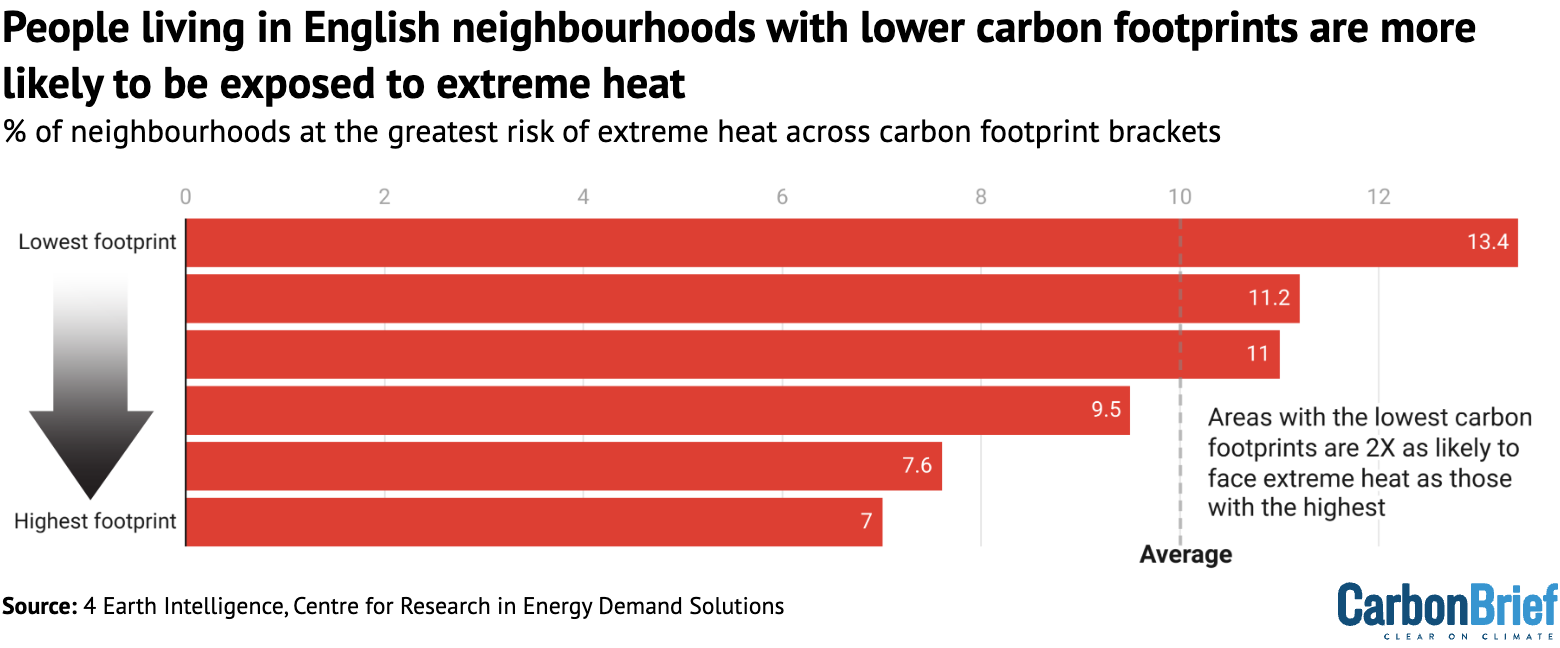
Neighbourhoods in England with lower carbon footprints are often in dense, urban areas, where people tend to be less reliant on cars and more likely to live in energy-efficient flats.
Areas with higher carbon footprints are commonly found in rural areas, where travelling by car can be a necessity due to limited public transport.
Also, particularly in south-east England, people in these rural neighbourhoods are often wealthier, meaning they spend more money on flights and other high-emitting luxuries.
Ethnicity and deprivation
Carbon Brief also analysed the heat threat facing deprived neighbourhoods in England and those that are home to more people of colour.
Information about how many people identify as black, Asian and other minority ethnicities in each neighbourhood is based on 2021 census data, via the Office for National Statistics.
As the chart below shows, there is a clear correlation between the number of people of colour living in a neighbourhood and the likelihood of it facing extreme heat during periods of hot weather.
The most ethnically diverse neighbourhoods – where roughly half or more of the population are people of colour – are 15 times more likely to have high heat hazard scores than the least ethnically diverse neighbourhoods, where almost everyone is white.
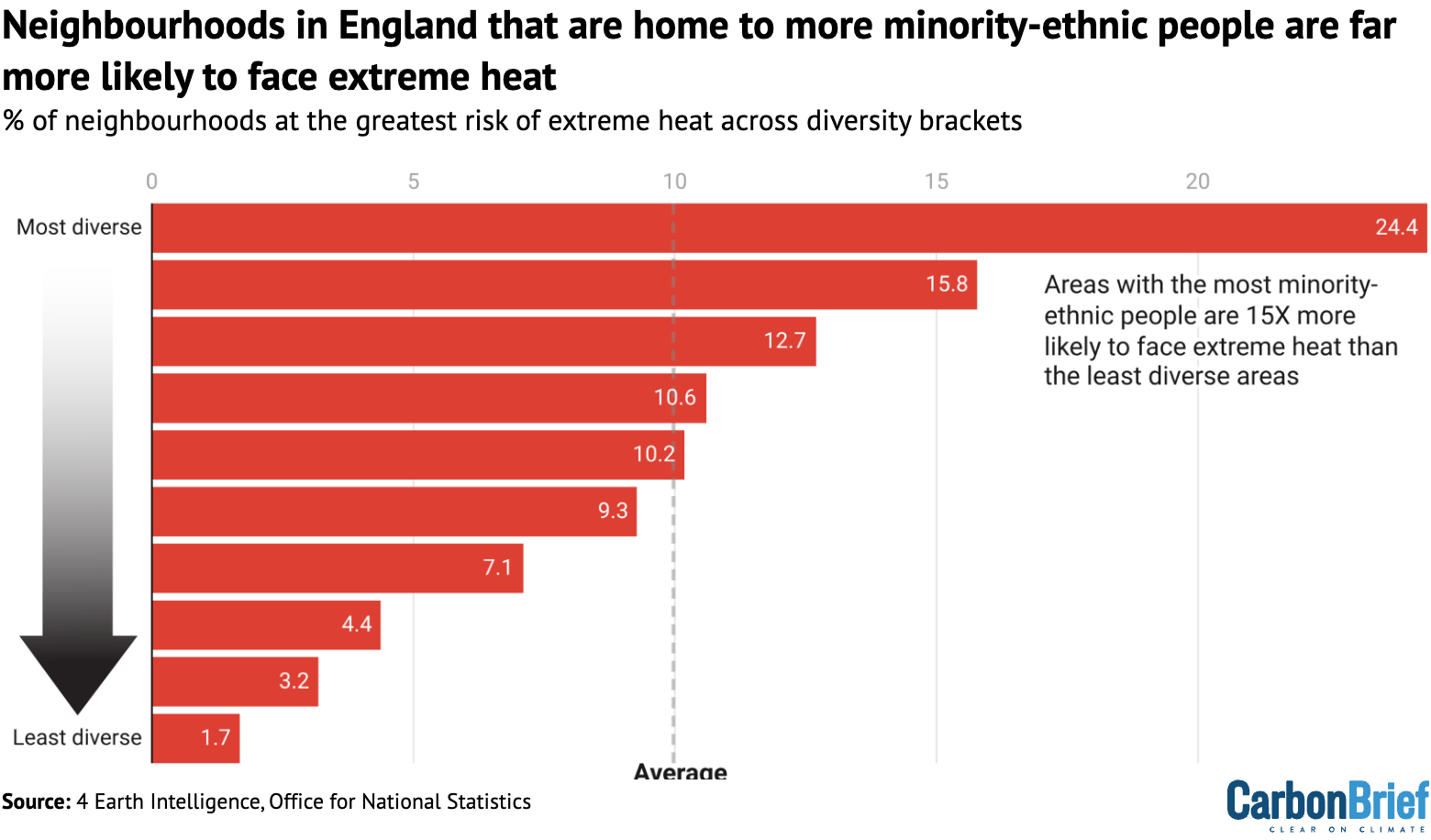
Among the most diverse areas are parts of Newham in east London, Saltley in Birmingham and Spinney Hills in Leicester, all of which are inner-city areas.
The least diverse neighbourhoods range from coastal parts of Redcar and Cleveland in North Yorkshire to the rural villages of south Somerset. None of England’s hottest 1% of neighbourhoods are in this bracket.
Additionally, Carbon Brief assessed the relationship between levels of poverty and heat risk, based on England’s indices of deprivation dataset. This covers several measures of deprivation, including income, employment and health.
People living in the most deprived English neighbourhoods are more than three times as likely to face high levels of heat hazard as those in the least deprived neighbourhoods, as shown in the figure below.
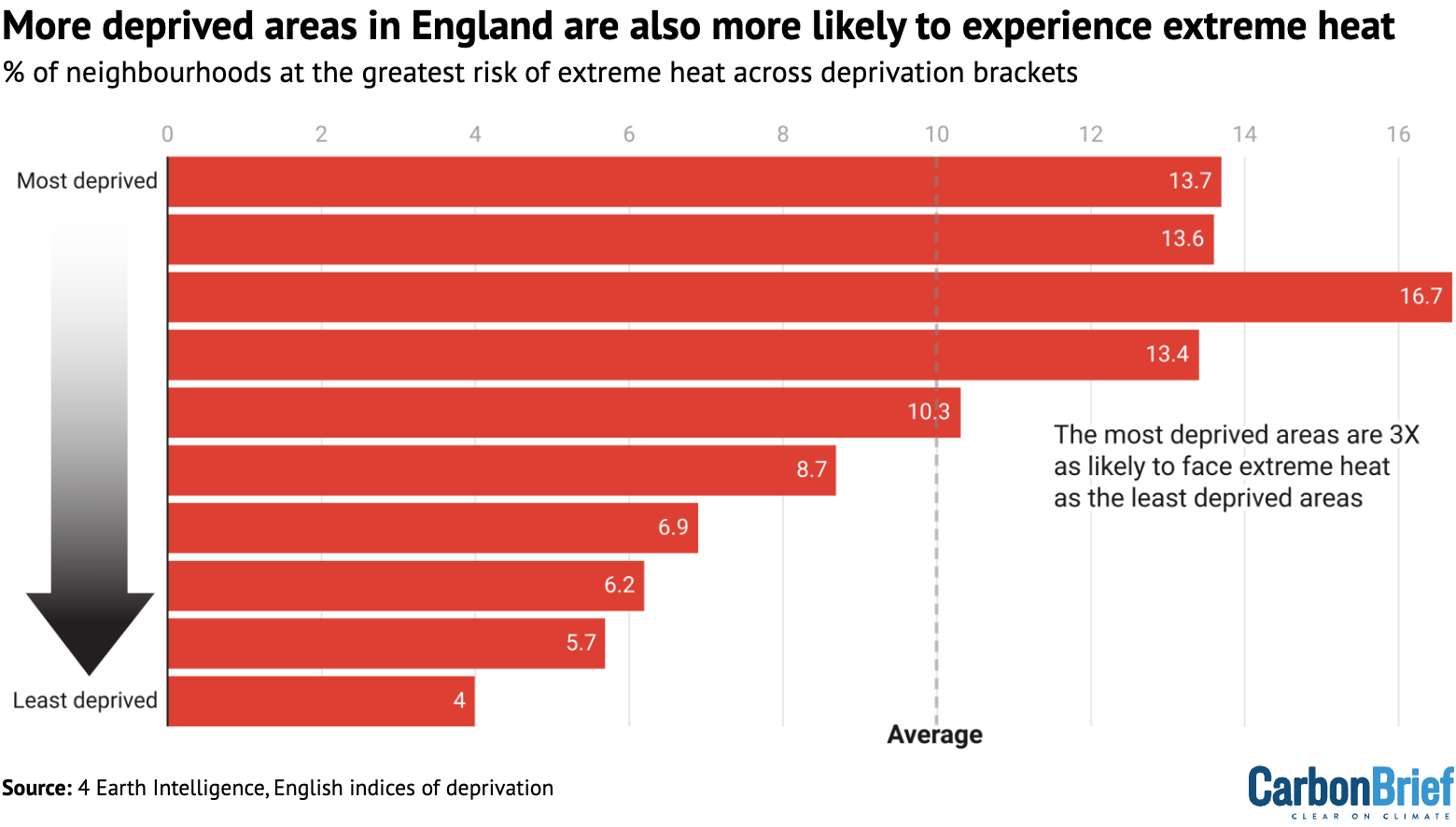
The correlation between poverty and extreme heat is less extreme than the one between heat exposure and ethnicity.
While many of England’s most deprived areas are in cities, they are also clustered in some rural and coastal areas – such as parts of Cornwall and Lincolnshire – which tend to be cooler.
Urban heat island
The key phenomenon captured by this analysis is the urban heat island effect. This describes how cities – and particularly areas with dense buildings, roads and stretches of concrete that absorb heat – tend to be hotter than the surrounding countryside.
Cities such as London, Manchester and Birmingham have reached temperatures up to 5C hotter than the surrounding areas in recent decades, due to this effect.
The diagram below shows how air flows circulate between rural and urban areas, forming “heat domes” over cities.
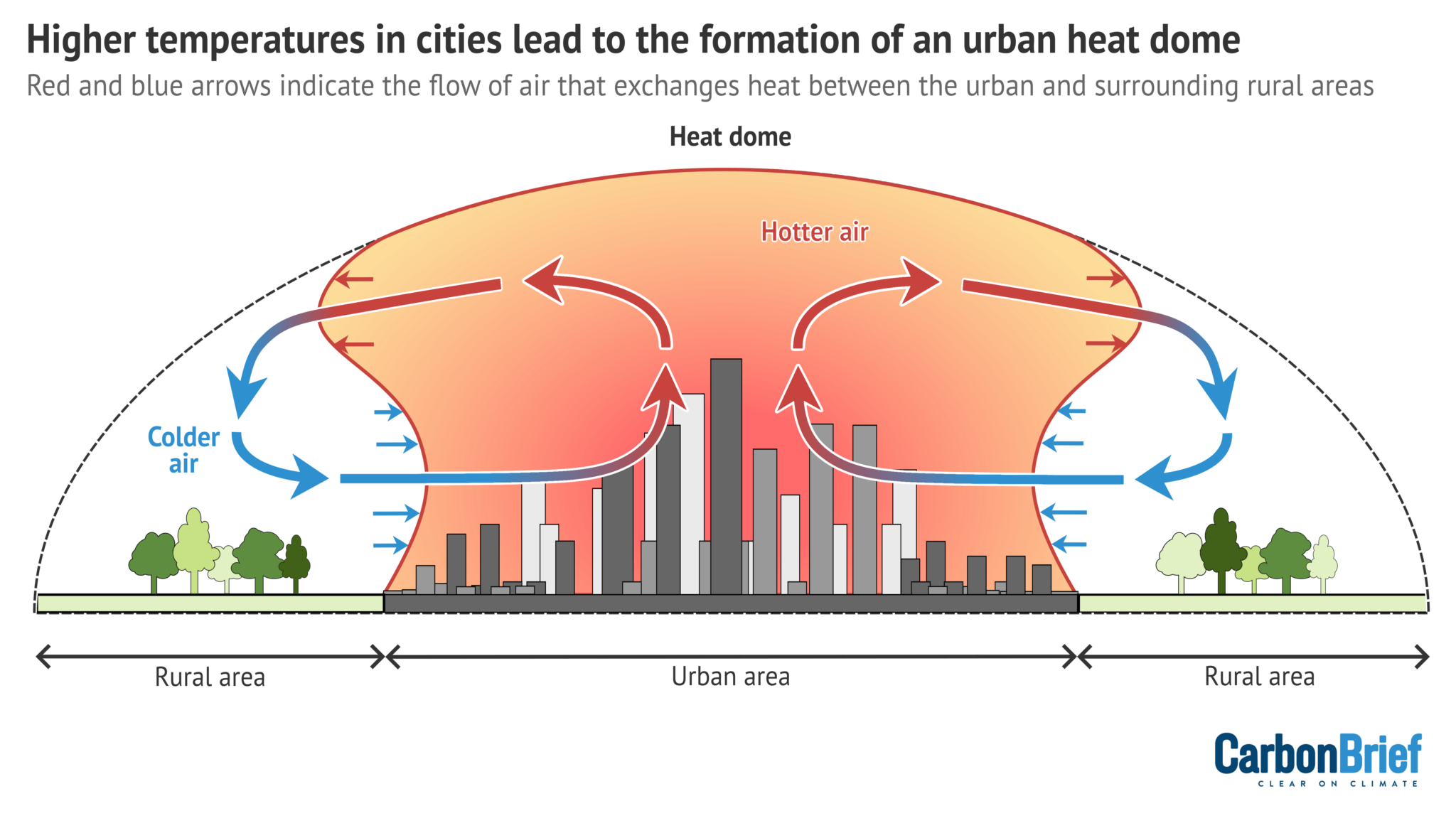
Inner-city areas in England are also home to many people facing high levels of deprivation, as well as large black and Asian communities. Many of these communities are therefore exposed to more dangerous temperatures due to the urban heat island effect.
Access to green spaces, even within cities, also influences exposure to the urban heat island effect. Research has shown how people in deprived areas and people of colour – particularly black people – are more likely to live in areas with less access to green spaces.
There is already extensive scientific literature that uses satellite data to demonstrate the urban heat island effect in cities and other locations.
A number of studies have also used this data to show how people of colour and those living in poverty are more exposed to extreme heat. Much of this research has come from the US, where historic housing inequalities have created stark patterns of segregation in many cities.
A project led by environmental policy researcher Dr Angel Hsu of the University of North Carolina-Chapel Hill shows how, globally, “cities are burdening lower-income populations with higher heat exposure”, as she tells Carbon Brief.
Given this, Hsu adds that “it’s not surprising to us to see similar disproportionate exposure patterns among UK neighbourhoods”.
Other researchers tell Carbon Brief that it is important to be wary of satellite data, as it does not precisely capture the air temperatures experienced in these neighbourhoods.
Dr Charles Simpson, who researches the health and economic impacts of climate change at University College London (UCL), notes:
“Satellite-measured surface temperature does not always correlate with the air temperature – what you are measuring includes a lot of road surfaces and rooftops. The air temperature is thought to be more directly relevant to people’s health and their cooling needs.”
Previous research has found that satellite data can therefore overestimate the urban heat island effect compared to data from weather stations.
These stations, however, are not widespread enough to allow comparisons with detailed neighbourhood data. They are particularly lacking in more deprived areas in England, potentially making measurements there less reliable.
Other scientists tell Carbon Brief that, in the absence of a comprehensive ground monitoring network, satellite measurements can serve as a stand-in to estimate heat exposure. Dr Chloe Brimicombe, an extreme-heat researcher based at the University of Graz, explains:
“Although it’s not a good indicator of perceived [temperature], it is a good indicator of what regions are most built up and have the environments that are most vulnerable to heat.”
‘Amplifying’ inequalities
There is a growing body of evidence gathered by activists, scientists and local governments around the UK revealing the unequal burden of climate change.
Dr Charles Ogunbode, an assistant professor of applied psychology at the University of Nottingham who specialises in how people experience climate change, tells Carbon Brief that this kind of data helps to clarify the links between climate change and inequalities:
“We can’t avoid dealing with the issue of social inequalities and climate change is just basically amplifying those things. It’s highlighting them, it’s revealing them. So whatever policies we put in place – be it in the health sector, be it in the climate sector – addressing those inequalities has to be an essential part of whatever those responses are.”
There are many factors influencing how people experience heat that are not captured in Carbon Brief’s analysis.
Previous work by researchers at the University of Manchester and Friends of the Earth has explored this issue, including an analysis of more than 40 indicators that could make neighbourhoods more “socially vulnerable” to heat.
This reveals similar outcomes, with people of colour and those contributing the least to climate change generally more vulnerable to its impacts.
One of the biggest factors that contributes to people’s exposure to heat extremes in the UK is the country’s housing stock, which is “not fit for the future”, according to the CCC.
UK homes have generally not been built for hotter conditions and poorer people are more likely to live in badly adapted housing. Those living in small homes, flats and social housing in England all “suffer significantly more overheating” during heatwaves, according to one study.
Dr Giorgos Petrou, a researcher in building physics modelling at UCL, tells Carbon Brief that it is also vital to consider whether households have the ability to adapt to climate change. “Amongst other factors, their capability will depend on their financial means and whether they own or rent their home,” he says.
Experts tell Carbon Brief that the government should act across its policy agenda to not only address extreme heat, but also support those who are most affected by it. This could involve expanding tree cover and renovating old social housing stock in at-risk communities.
Emma Howard Boyd, a former chair of the Environment Agency who also chaired the London Climate Resilience Review, tells Carbon Brief:
“I do think that with [the Labour] government focusing on house building and retrofit, this is a fantastic opportunity to get this right…For those communities that have had the least impact on the environment and climate change themselves.”
Methodology
This analysis collates several datasets that cover England at a neighbourhood level, with “neighbourhoods” defined as lower-layer super output areas (LSOAs). These are small statistical areas used by the UK government, covering populations of about 1,500-3,000 people. There are 33,755 LSOAs in England.
Data on vulnerability to heat comes from 4 Earth Intelligence (4EI), which analyses land surface temperature to generate “heat hazard” information at a 30m resolution. This detailed information has been converted into LSOAs by 4EI.
Heat hazard scores are calculated by 4EI, based on the likelihood that a given neighbourhood will experience high temperatures during hot weather, relative to the surrounding area.
Each score corresponds to a different percentile of English neighbourhoods. The bar below shows the percentage breakdown across all LSOAs in England.
The two hottest scores – those coloured in red – correspond to the 10% of English neighbourhoods that have higher heat hazard scores than the remaining 90%.

For simplicity, Carbon Brief’s analysis focuses on the red bars above, meaning neighbourhoods in either the top 90th-99th percentile or 99th percentile of heat hazard. (Neighbourhoods in the 90th-99th percentile have higher heat hazard scores than 90% of areas in England. Neighbourhoods in the 99th percentile have higher heat hazard scores than 99% of areas.)
It shows how these two scores are overrepresented in LSOAs that have lower carbon footprints, more diverse communities and higher levels of deprivation.
Carbon-footprint data is from the CREDS “place-based carbon calculator”, which estimates the average per-person carbon footprint for every LSOA in England. It accounts for emissions-producing activities ranging from electricity use to “consumption of goods and services”.
CREDS assigns the grades “A” to “F” (low carbon footprint to high carbon footprint) to neighbourhoods. Carbon Brief has based its carbon-footprint analysis on these grades.
LSOA-level data on black, Asian and other minority-ethnic populations comes from 2021 census data. English LSOAs were broken down into deciles, based on the percentage of the population that identified as non-white ethnicities.
The lowest decile covered the tenth of LSOAs with between 0 and 2% non-white minority-ethnic populations and the highest covered the tenth with more than 51%.
England’s indices of multiple deprivation dataset also includes LSOA-level information. It provides relative measures of deprivation for LSOAs in England, based on income, employment, education, health, crime, living environment and barriers to housing and services. Carbon Brief broke the LSOAs down into deciles based on the total deprivation scores, from the most deprived to the least deprived.
The post Analysis: England’s most ethnically diverse areas are 15 times more likely to face extreme heat appeared first on Carbon Brief.
Analysis: England’s most ethnically diverse areas are 15 times more likely to face extreme heat
-
Climate Change2 years ago
Spanish-language misinformation on renewable energy spreads online, report shows
-
Climate Change Videos2 years ago
The toxic gas flares fuelling Nigeria’s climate change – BBC News
-

 Greenhouse Gases1 year ago
Greenhouse Gases1 year ago嘉宾来稿:满足中国增长的用电需求 光伏加储能“比新建煤电更实惠”
-

 Climate Change1 year ago
Climate Change1 year ago嘉宾来稿:满足中国增长的用电需求 光伏加储能“比新建煤电更实惠”
-

 Carbon Footprint1 year ago
Carbon Footprint1 year agoUS SEC’s Climate Disclosure Rules Spur Renewed Interest in Carbon Credits
-
Climate Change2 years ago
Why airlines are perfect targets for anti-greenwashing legal action
-
Climate Change Videos2 years ago
The toxic gas flares fuelling Nigeria’s climate change – BBC News
-
Climate Change2 years ago
Some firms unaware of England’s new single-use plastic ban

